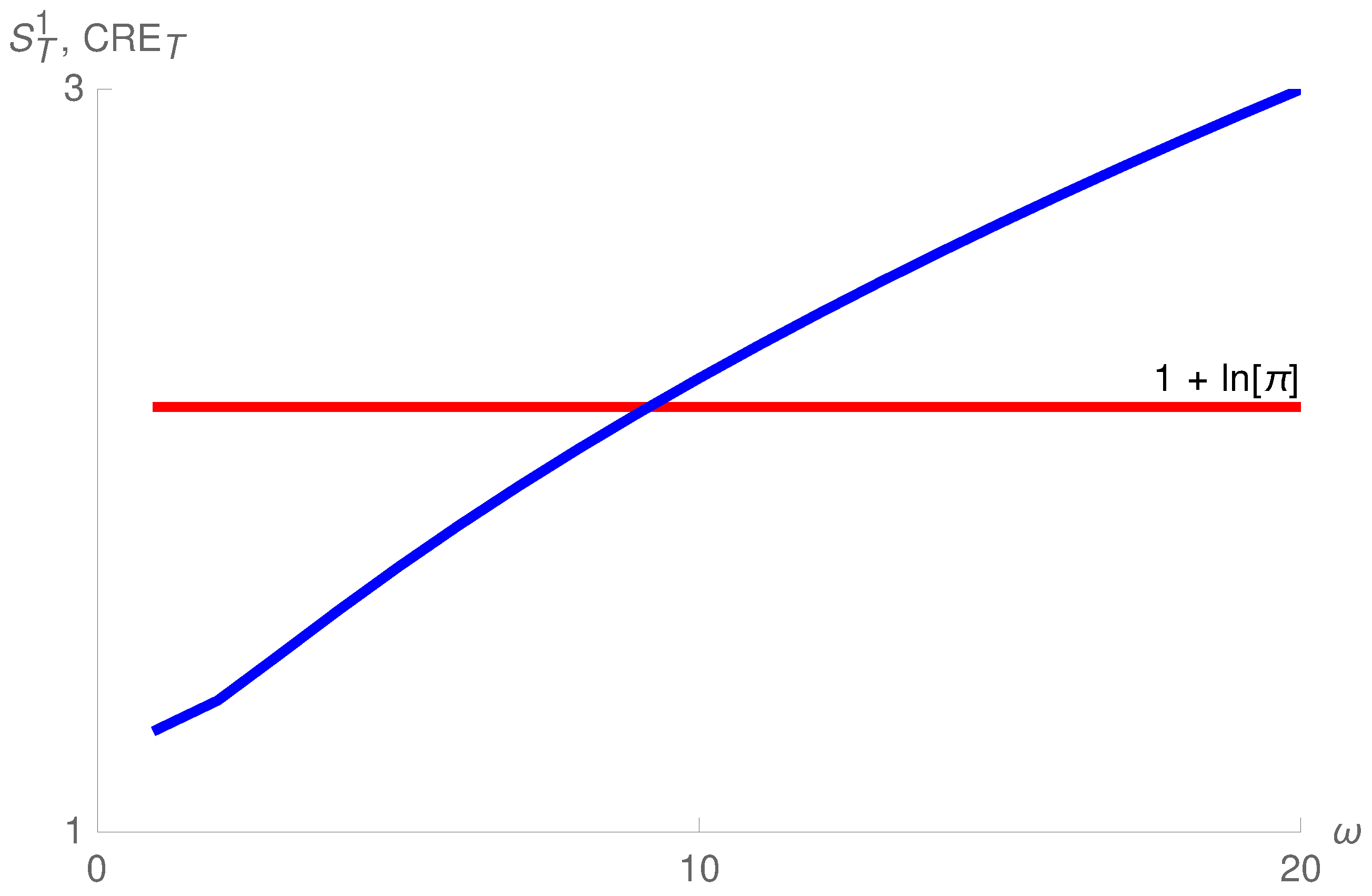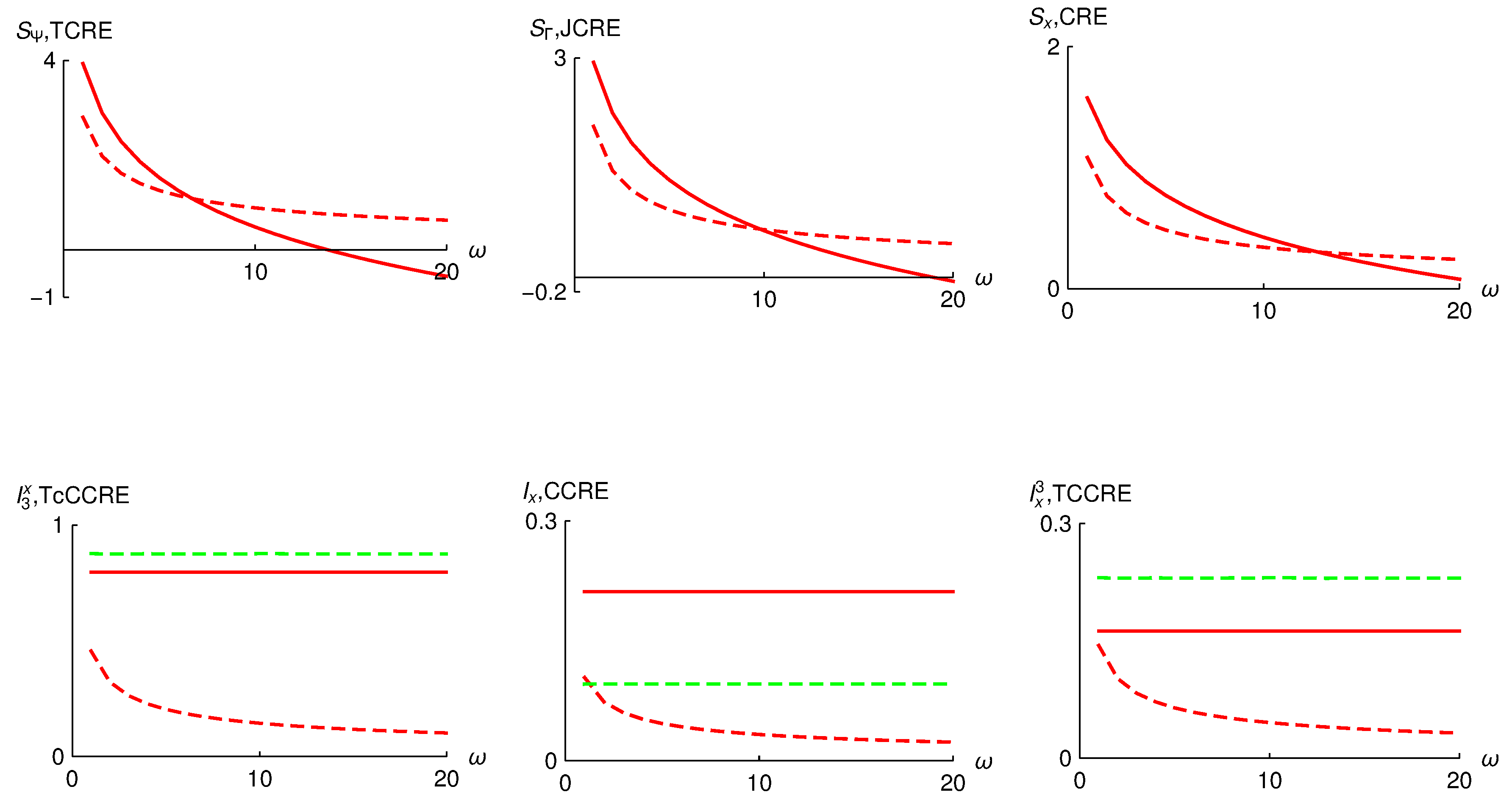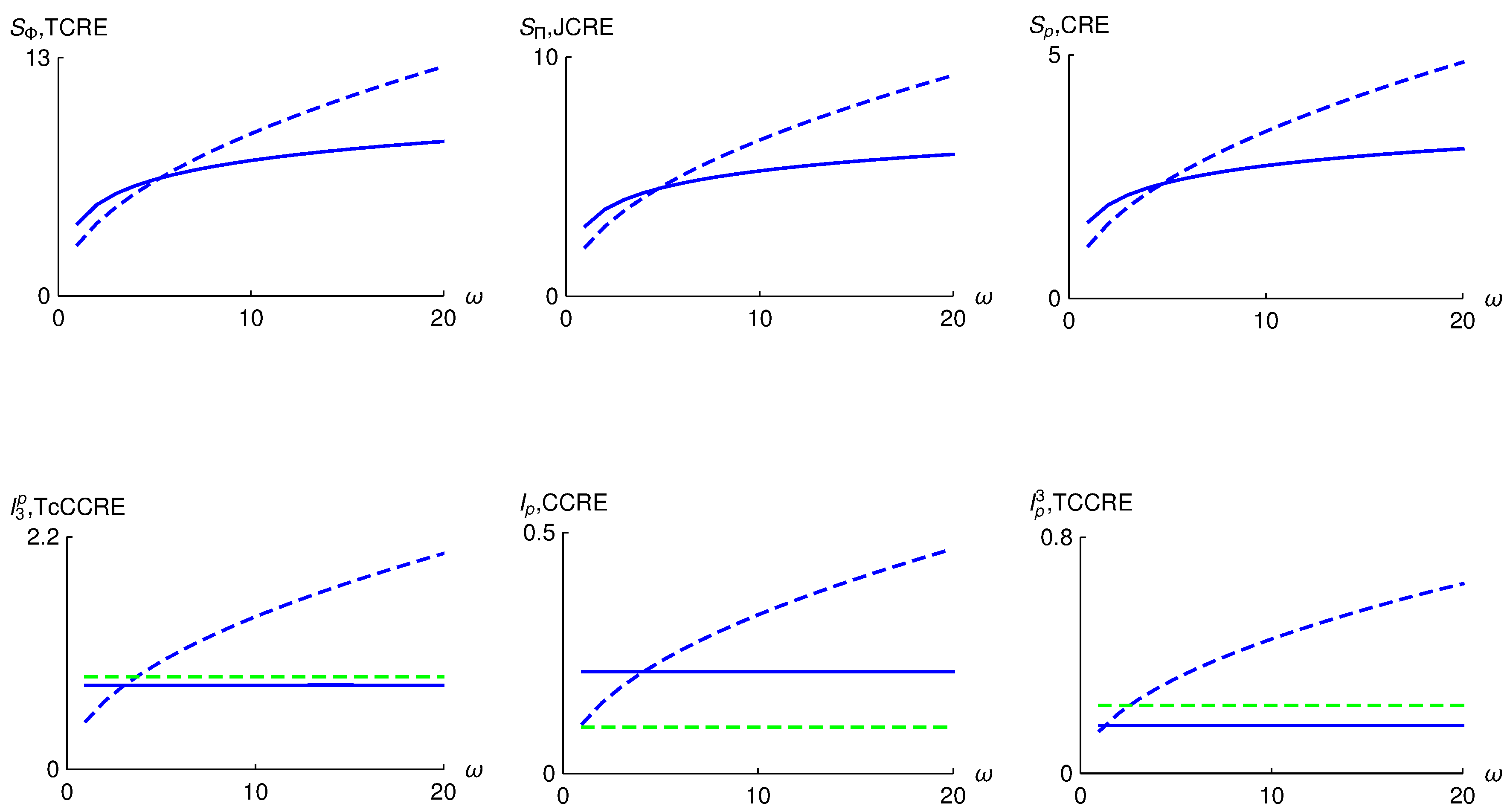Higher-Order Information Measures from Cumulative Densities in Continuous Variable Quantum Systems
Abstract
1. Introduction
2. Two-Variable Information Measures
2.1. Entropies from Two-Variable Distributions
2.2. Pairwise Statistical Correlation Measures
3. Three-Variable Information Measures
3.1. Entropies from Three-Variable Distributions
3.2. Triple-Wise Statistical Correlation Measures
4. Three Uncoupled and Coupled Oscillators
5. Results
5.1. Uncoupled Oscillators
5.2. Interacting Oscillators: Symmetric Wave Function
5.3. Interacting Oscillators: Antisymmetric Wave Function
6. Conclusions
Author Contributions
Funding
Acknowledgments
Conflicts of Interest
Appendix A. Entropic Sums



References
- Shannon, C. A Mathematical Theory of Communication. Bell Syst. Tech. J. 1948, 27, 379–423. [Google Scholar] [CrossRef]
- Cover, T.M.; Thomas, J.A. Elements of Information Theory; John Wiley and Sons: New York, NY, USA, 1991. [Google Scholar]
- Matta, C.F.; Sichinga, M.; Ayers, P.W. Information theoretic properties from the quantum theory of atoms in molecules. Chem. Phys. Lett. 2011, 514, 379. [Google Scholar] [CrossRef]
- Flores-Gallegos, N. On the calculations of Shannon’s entropy in atoms and molecules I: The continuous case in position and momentum spaces. Chem. Phys. Lett. 2019, 720, 1–6. [Google Scholar] [CrossRef]
- Nascimento, W.S.; Prudente, F.V. Shannon entropy: A study of confined hydrogenic-like atoms. Chem. Phys. Lett. 2018, 691, 401–407. [Google Scholar] [CrossRef]
- Nascimento, W.S.; de Almeida, M.M.; Prudente, F.V. Information and quantum theories: An analysis in one-dimensional systems. Eur. J. Phys. 2020, 41, 025405. [Google Scholar] [CrossRef]
- Gadre, S.R.; Sears, S.B.; Chakravorty, S.J.; Bendale, R.D. Some novel characteristics of atomic information entropies. Phys. Rev. A 1985, 32, 2602–2606. [Google Scholar] [CrossRef]
- Gadre, S.R.; Bendale, R.D. Rigorous relationships among quantum-mechanical kinetic energy and atomic information entropies: Upper and lower bounds. Phys. Rev. A 1987, 36, 1932. [Google Scholar] [CrossRef]
- Hô, M.; Sagar, R.P.; Weaver, D.F.; Smith, V., Jr. An investigation of the dependence of Shannon information entropies and distance measures on molecular geometry. Int. J. Quantum Chem. 1995, 56, 109–115. [Google Scholar] [CrossRef]
- Grassi, A.; Lombardo, G.M.; March, N.H.; Pucci, R. 1/Z expansion, correlation energy, and Shannon entropy of heavy atoms in nonrelativistic limit. Int. J. Quantum Chem. 1998, 69, 721–726. [Google Scholar] [CrossRef]
- Fuentealba, P.; Melin, J. Atomic spin-density polarization index and atomic spin-density information entropy distance. Int. J. Quantum Chem. 2002, 90, 334. [Google Scholar] [CrossRef]
- Guevara, N.L.; Sagar, R.P.; Esquivel, R.O. Shannon-information entropy sum as a correlation measure in atomic systems. Phys. Rev. A 2003, 67, 012507. [Google Scholar] [CrossRef]
- Romera, E.; Dehesa, J.S. The Fisher-Shannon information plane, an electron correlation tool. J. Chem. Phys. 2004, 120, 8906–8912. [Google Scholar] [CrossRef]
- Shi, Q.; Kais, S. Finite size scaling for the atomic Shannon-information entropy. J. Chem. Phys. 2004, 121, 5611–5617. [Google Scholar] [CrossRef]
- Atre, R.; Kumar, A.; Kumar, N.; Panigrahi, P.K. Quantum-information entropies of the eigenstates and the coherent state of the Pöschl-Teller potential. Phys. Rev. A 2004, 69, 052107. [Google Scholar] [CrossRef]
- Sen, K.D. Characteristic features of Shannon information entropy of confined atoms. J. Chem. Phys. 2005, 123, 074110. [Google Scholar] [CrossRef]
- Chatzisavvas, K.C.; Moustakidis, C.C.; Panos, C.P. Information entropy, information distances, and complexity in atoms. J. Chem. Phys. 2005, 123, 174111. [Google Scholar] [CrossRef]
- Huang, Z.; Kais, S. Entanglement as measure of electron-electron correlation in quantum chemistry calculations. Chem. Phys. Lett. 2005, 413, 1. [Google Scholar] [CrossRef]
- Sen, K.; Katriel, J. Information entropies for eigendensities of homogeneous potentials. J. Chem. Phys. 2006, 125, 074117. [Google Scholar] [CrossRef] [PubMed]
- Liu, S. On the relationship between densities of Shannon entropy and Fisher information for atoms and molecules. J. Chem. Phys. 2007, 126, 191107. [Google Scholar] [CrossRef]
- Luzanov, A.V.; Prezhdo, O.V. High-order entropy measures and spin-free quantum entanglement for molecular problems. Mol. Phys. 2007, 105, 2879. [Google Scholar] [CrossRef]
- Antolín, J.; Angulo, J.C.; López-Rosa, S. Fisher and Jensen-Shannon divergences: Quantitative comparisons among distributions. Application to position and momentum atomic densities. J. Chem. Phys. 2009, 130, 074110. [Google Scholar] [CrossRef] [PubMed]
- Ghiringhelli, L.M.; Hamilton, I.P.; Delle Site, L. Interacting electrons, spin statistics, and information theory. J. Chem. Phys. 2010, 132, 014106. [Google Scholar] [CrossRef]
- Alipour, M.; Mohajeri, A. On the relationship between one-electron potential and densities of Fisher information and Shannon entropy. Chem. Phys. 2012, 392, 105–106. [Google Scholar] [CrossRef]
- Pineda-Urbina, K.; Guerrero, R.D.; Reyes, A.; Gómez-Sandoval, Z.; Flores-Moreno, R. Shape entropy’s response to molecular ionization. J. Mol. Model. 2013, 19, 1677. [Google Scholar] [CrossRef]
- Xing, Y.; Wu, J. Controlling the Shannon Entropy of Quantum Systems. Sci. World J. 2013, 381219. [Google Scholar] [CrossRef]
- Sun, G.H.; Dong, S.H.; Saad, N. Quantum information entropies for an asymmetric trigonometric Rosen-Morse potential. Ann. Phys. 2013, 525, 934–943. [Google Scholar] [CrossRef]
- Nagy, Á. Shannon entropy density as a descriptor of Coulomb systems. Chem. Phys. Lett. 2013, 556, 355–358. [Google Scholar] [CrossRef]
- Aquino, N.; Flores-Riveros, A.; Rivas-Silva, J.F. Shannon and Fisher entropies for a hydrogen atom under soft spherical confinement. Phys. Lett. A 2013, 377, 2062–2068. [Google Scholar] [CrossRef]
- Nagy, Á. Fisher and Shannon information in orbital-free density functional theory. Int. J. Quantum Chem. 2014, 115, 1392–1395. [Google Scholar] [CrossRef]
- Sun, G.H.; Dong, S.H.; Launey, K.D.; Dytrych, T.; Draayer, J.P. Shannon information entropy for a hyperbolic double-well potential. Int. J. Quantum Chem. 2015, 115, 891. [Google Scholar] [CrossRef]
- Olendski, O. Comparative analysis of electric field influence on the quantum wells with different boundary conditions. Ann. Phys. (Berl.) 2015, 527, 278. [Google Scholar] [CrossRef]
- Mukerjee, N.; Roy, A.; Roy, A.K. Information entropy as a measure of tunneling and quantum confinement in a symmetric double-well potential. Ann. Phys. 2015, 527, 825–845. [Google Scholar] [CrossRef]
- Fotue, A.J.; Kenfack, S.C.; Tiotsup, M.; Issofa, N.; Wirngo, A.V.; Djemmo, M.P.T.; Fotsin, H.; Fai, L.C. Shannon entropy and decoherence of bound magnetopolaron in a modified cylindrical quantum dot. Mod. Phys. Lett. B 2015, 29, 1550241. [Google Scholar] [CrossRef]
- Lin, C.H.; Ho, Y.K. Shannon information entropy in position space for two-electron atomic systems. Chem. Phys. Lett. 2015, 633, 261–264. [Google Scholar] [CrossRef]
- Delle Site, L. Shannon entropy and many-electron correlations: Theoretical concepts, numerical results, and Collins conjecture. Int. J. Quantum Chem. 2015, 115, 1396–1404. [Google Scholar] [CrossRef]
- Mukerjee, N.; Roy, A.K. Quantum confinement in an asymmetric double-well potential through energy analysis and information entropic measure. Ann. Phys. 2016, 528, 412–433. [Google Scholar] [CrossRef]
- Ghafourian, M.; Hassanabadi, H. Shannon information entropies for the three-dimensional Klein-Gordon problem with the Poschl-Teller potential. J. Korean Phys. Soc. 2016, 68, 1267–1271. [Google Scholar] [CrossRef]
- Najafizade, S.A.; Hassanabadi, H.; Zarrinkamar, S. Nonrelativistic Shannon information entropy for Kratzer potential. Chin. Phys. B 2016, 25, 040301. [Google Scholar] [CrossRef]
- Aguiar, V.; Guedes, I. Entropy and information of a spinless charged particle in time-varying magnetic fields. J. Math. Phys. 2016, 57, 092103. [Google Scholar] [CrossRef]
- Olendski, O. Theory of the Robin quantum wall in a linear potential. I. Energy spectrum, polarization and quantum-information measures. Ann. Phys. (Berl.) 2016, 528, 865. [Google Scholar] [CrossRef]
- Ghosal, A.; Mukherjee, N.; Roy, A.K. Information entropic measures of a quantum harmonic oscillator in symmetric and asymmetric confinement within an impenetrable box. Ann. Phys. (Berl.) 2016, 528, 796. [Google Scholar] [CrossRef]
- Martínez-Sánchez, M.A.; Vargas, R.; Garza, J. Shannon Entropy for the Hydrogen Atom Confined by Four Different Potentials. Quantum Rep. 2019, 1, 208–218. [Google Scholar] [CrossRef]
- Bialynicki-Birula, I.; Mycielski, J. Uncertainty relations for information entropy in wave mechanics. J. Commun. Math. Phys. 1975, 44, 129–132. [Google Scholar] [CrossRef]
- Hertz, A.; Cerf, N.J. Continuous-variable entropic uncertainty relations. J. Phys. A Math. Theor. 2019, 52, 173001. [Google Scholar] [CrossRef]
- Rao, M.; Chen, Y.; Vemuri, B.C.; Wang, F. Cumulative Residual Entropy: A New Measure of Information. IEEE Trans. Inf. Theory 2004, 50, 1220. [Google Scholar] [CrossRef]
- Laguna, H.G.; Sagar, R.P. Information theoretical measures from cumulative and survival densities in quantum systems. Int. J. Quantum Chem. 2017, 117, e25387. [Google Scholar] [CrossRef]
- Laguna, H.G.; Sagar, R.P. Statistical correlations in the Moshinsky atom. Phys. Rev. A 2011, 84, 012502. [Google Scholar] [CrossRef]
- Löwdin, P.O. Quantum Theory of Many-Particle Systems. III. Extension of the Hartree-Fock Scheme to Include Degenerate Systems and Correlation Effects. Phys. Rev. 1955, 97, 1509. [Google Scholar] [CrossRef]
- Kutzelnigg, W.; Re, G.D.; Berthier, G. Correlation Coefficients for Electronic Wave Functions. Phys. Rev. 1968, 172, 49. [Google Scholar] [CrossRef]
- Thakkar, A.J.; Smith, V.H., Jr. Statistical electron correlation coefficients for the five lowest states of the heliumlike ions. Phys. Rev. A 1981, 23, 473. [Google Scholar] [CrossRef]
- Wang, F.; Vemuri, B.C. Non-Rigid Multi-Modal Image Registration Using Cross-Cumulative Residual Entropy. Int. J. Comput. Vis. 2007, 74, 201. [Google Scholar] [CrossRef]
- Cahill, N.D.; Schnabel, J.A.; Noble, J.A.; Hawkes, D.J. Overlap Invariance of Cumulative Residual Entropy Measures for Multimodal Image Alignment. Proc. SPIE 2009, 7259, 72590I. [Google Scholar] [CrossRef]
- Panzeri, S.; Schultz, S.R.; Treves, A.; Rolls, E.T. Correlations and the encoding of information in the nervous system. Proc. R. Soc. Lond. B 1999, 266, 1001–1012. [Google Scholar] [CrossRef]
- Schneidman, E.; Bialek, W.; Berry, M.J. Synergy, Redundancy, and Independence in Population Codes. J. Neurosci. 2003, 23, 11539–11553. [Google Scholar] [CrossRef]
- Latham, P.E.; Nirenberg, S. Synergy, Redundancy, and Independence in Population Codes, Revisited. J. Neurosci. 2005, 25, 5195–5206. [Google Scholar] [CrossRef]
- Beraha, M.; Metelli, A.; Papini, M.; Tirinzoni, A.; Restelli, M. Feature Selection via Mutual Information: New Theoretical Insights. arXiv 2019, arXiv:1907.07384v1. [Google Scholar]
- Matsuda, H. Physical nature of higher-order mutual information: Intrinsic correlations and frustration. Phys. Rev. E 2000, 62, 3096–3102. [Google Scholar] [CrossRef] [PubMed]
- Matsuda, H. Information theoretic characterization of frustrated systems. Physics A 2001, 294, 180–190. [Google Scholar] [CrossRef]
- Salazar, S.; Laguna, H.; Sagar, R. Higher-order statistical correlations in three-particle quantum systems with harmonic interactions. Phys. Rev. A 2020, 101, 042105. [Google Scholar] [CrossRef]
- Yépez, V.S.; Sagar, R.P.; Laguna, H.G. Higher-Order Statistical Correlations and Mutual Information among Particles in a Quantum Well. Few-Body Syst. 2017, 58, 158. [Google Scholar] [CrossRef]
- McGill, W.J. Multivariate information transmission. Psychometrika 1954, 19, 97–116. [Google Scholar] [CrossRef]
- Cerf, N.J.; Adami, C. Entropic Bell inequalities. Phys. Rev. A 1997, 55, 3371–3374. [Google Scholar] [CrossRef]
- Watanabe, S. Information theoretical analysis of multivariate correlation. IBM J. Res. Dev. 1960, 4, 66–82. [Google Scholar] [CrossRef]
- Han, T.S. Multiple mutual informations and multiple interactions in frequency data. Inf. Control 1980, 46, 26–45. [Google Scholar] [CrossRef]
- Peng, H.T.; Ho, Y.K. Statistical Correlations of the N-particle Moshinsky Model. Entropy 2015, 17, 1882. [Google Scholar] [CrossRef]
- Bouvrie, P.A.; Majtey, A.P.; Plastino, A.R.; Sánchez, M.P.; Dehesa, J.S. Quantum entanglement in exactly soluble atomic models: The Moshinsky model with three electrons, and with two electrons in a uniform magnetic field. Eur. Phys. J. D 2012, 66, 15. [Google Scholar] [CrossRef]









Publisher’s Note: MDPI stays neutral with regard to jurisdictional claims in published maps and institutional affiliations. |
© 2020 by the authors. Licensee MDPI, Basel, Switzerland. This article is an open access article distributed under the terms and conditions of the Creative Commons Attribution (CC BY) license (http://creativecommons.org/licenses/by/4.0/).
Share and Cite
Salazar, S.J.C.; Laguna, H.G.; Sagar, R.P. Higher-Order Information Measures from Cumulative Densities in Continuous Variable Quantum Systems. Quantum Rep. 2020, 2, 560-578. https://doi.org/10.3390/quantum2040039
Salazar SJC, Laguna HG, Sagar RP. Higher-Order Information Measures from Cumulative Densities in Continuous Variable Quantum Systems. Quantum Reports. 2020; 2(4):560-578. https://doi.org/10.3390/quantum2040039
Chicago/Turabian StyleSalazar, Saúl J. C., Humberto G. Laguna, and Robin P. Sagar. 2020. "Higher-Order Information Measures from Cumulative Densities in Continuous Variable Quantum Systems" Quantum Reports 2, no. 4: 560-578. https://doi.org/10.3390/quantum2040039
APA StyleSalazar, S. J. C., Laguna, H. G., & Sagar, R. P. (2020). Higher-Order Information Measures from Cumulative Densities in Continuous Variable Quantum Systems. Quantum Reports, 2(4), 560-578. https://doi.org/10.3390/quantum2040039





